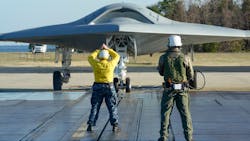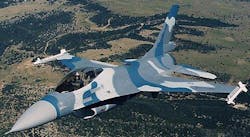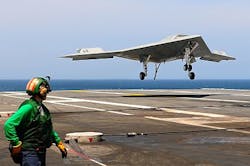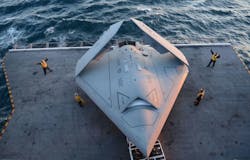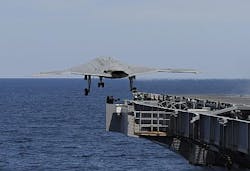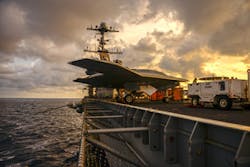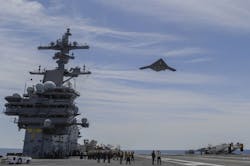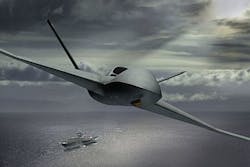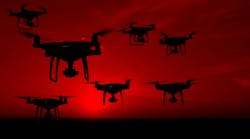NAME: Jimmy Reed
TITLE: director of advanced engine programs
CO.: Pratt & Whitney
ROLE: Creating, developing, and validating all the propulsion technologies that will be required in the future
CONTACT: www.pw.utc.com
Pratt & Whitney’s director of advanced engine programs discusses the unique power and thermal requirements of the Northrop Grumman X-47Bunmanned combat air system (UCAS), which is rapidly achieving aerospace and defense milestones.
What is your role at Pratt & Whitney?
As director of advanced programs at Pratt & Whitney, I’m not involved with anything in production today; rather, I’m responsible for future systems, flying platforms like the X-47. Getting ready for the next generation of fighter airplanes over the next decades, we’re creating, developing, and validating all the propulsion technologies that we will require in the future.
You’re involved in the X-47B UCAS program?
Yes, the X-47 is a program that has been around since 2003 or 2004. We have been associated with Northrop [Grumman] on it since day one. It started as a DARPA program called Joint Unmanned Combat Air Systems (JUCAS); through a quadrennial defense review (QDR) many years ago, they directed the Navy to take over this unmanned combat role as the Air Force pursued other interests, and the Navy had a downselect of the X-45 or X-47 to go through the demonstration phase. They selected the X-47, fortunate for us—we have been a member of that team even in the days when there were two airplanes, and now there’s a single aircraft, the X-47. It is a program that has been a long time coming.
In the last several months, we have had many, many aviation firsts; they are all coming really quickly after a lot of years working very hard to make sure this good day would come. All of a sudden, it is coming very quick. As a result, the program is nearing the end as the Navy migrates to their next program. You have to savor the victories while you can because they take a long time to get there, and then they go quickly.
The engine in the X-47 is an F100 engine, based on the 220 model that is an F-16 unique and specific model; it powers most of the F-16 aircraft around the world. We selected that engine and modified it for this airplane. The predominant modification is a different exhaust system.
How are the X-47 and its engine needs unique?
The X-47 is a subsonic airplane; it could not fly supersonically and did not need more thrust beyond the 15,000 pounds that this engine provides as military power, maximum power without an afterburner. The 220 engine is known throughout industry and through the government as one of the most reliable and safe engines, and it also has an incredible tolerance for distortion, which is important in this program.
If you stand in front of the X-47 and try to see the engine looking through that big inlet, you can’t see it. The inlet is offset and, as a result, the air that arrives at the engine is in some cases distorted, meaning it’s not a smooth column of air. The engine has to be able to accommodate that and it does.
It also has to be able to accommodate steam ingestion that you sometimes get at the end of a catapult stroke. Given the integrity of the catapult, because there’s a wide range of really tight seals to really loose seals, some airplanes can get a big puff of steam just as they are leaving the boat. If you don’t have an engine that is very tolerant of that, well, it’s the wrong time to have a stall; it makes for a short flight, to make light of a serious situation.
Picking the right engine was critical for Northrop and for us. We have been pleased because the engines have been trouble free for the entire program.
Aircraft engines, especially on UAVs, are becoming increasing complex and incorporating advance, integrated electronics and electro-optics. Is that true of the F100?
The airplane directs the engine, but it directs an engine that we derive from an F-16. If we were designing an engine today for tomorrow’s airplanes, it would be very highly integrated with shared sensors and a shared control system, because that’s where the tendency is.
The X-47 is more federated; it provides a specific input to the engine to prove thrust. We provide shaft horsepower to drive generators, but generally it commands the engine and provides a certain level of thrust. It provides sensor inputs like temperatures, mach numbers, and other things—the engine’s control system is built onto the engine. It takes in and directs the engine accordingly.
The airplane and the engine actually talk different languages; the airplane has a more current communications protocol. The F100 engine uses F-16 protocol, so we have a device called the engine interface unit, a translator that sits between the airplane commands and the engine response. It does the conversion of information and commands. In that sense, if you and I were doing it today, that device wouldn’t exist; it exists here because of the engine that was selected for this application.
The follow-on programs, though, as these programs emerge, that integration is much more intense and much more shared—and that would be the future.
The X-47 has a tremendous amount of sensor information on the airplane, but the engine’s predominant role is to provide thrust. In that sense, it’s a good practice run for the future. We haven’t asked the engine to do much more than it’s already capable of.
We had to compete and this engine is the perfect fit. Had we needed a larger or higher-thrust engine, we have it in the family, but this was the perfect match of size, shape, and thrust that make it perfectly compatible for the X-47. If we were doing this engine today, we would want an engine that is more fuel efficient, and we have those engines, but it literally is the engine you don’t worry about. This engine has a reputation within the U.S. Air Force as the “Maytag engine” in the sense that it is so reliable. It is one of the lowest-maintenance engines in their entire inventory and one they trust their lives to everyday, but it also has a very, very strong maintenance reliability record. For those reasons, if you and I were building an airplane around an engine that we needed to get and we didn’t want to develop a new one, we’d go look for the most reliable, maintainable one that produced the right amount of thrust. Customers do say, “When I do this in the future, I want that level of thrust, but I want it to burn less fuel, generate more electrical power,” and the list goes on.
As we look at the future, beyond UCAS, that’s exactly what we will be accommodating in future designs. I don’t want to denigrate it like it’s not a big deal, because the X-47 is a huge deal, but what the engine provides is predominantly absolutely reliable thrust when you need it and when you want it.
If we turn the clock back 10 years, most of us thought that the unmanned vehicles of today might very well be machines that pull higher G loads than a pilot can stand. This is the concept of infinitely maneuverable and we were thinking we had to design engines that had completely different load capability because we were going to subject them to that. It ends up what has evolved, of course, are systems with lower G loads than even the manned aircraft. Will that always be the case, I don’t know, but if you look beyond UCAS at this program called Unmanned Carrier Launched Airborne Surveillance and Strike (UCLASS), it is focused on surveillance and combat performance. When we get into the next decade, whether they’re manned or unmanned, we will see demands for much higher maneuverability, and higher G loads in flight will cause us to design engines slightly differently.
Is it difficult designing a UAV engine to meet the needs of the U.S. Navy?
The Navy has a very unique set of requirements. They are at sea all the time, so this engine has to be able to accommodate a very harsh environment.
If you’ve seen pictures of waves pouring up over the front deck of a ship and bathing the airplanes and engines in seawater, that’s bad enough, but think about being in an airplane. We’re coming in to land on this ship, which is moving at 30 knots relative to the Earth, and we are trying to pick a spot on that deck to drop our hook. As we come in, we have to fly through something called a burble–a big air bubble that the carrier causes; it’s like the drafting behind a truck on the interstate. You’ve got that perturbation and then you’ve got to touch the deck, you’ve got to drop the hook, you’ve got three or four wires to catch–but what if you don’t? What if the hook hops or the wire is in wrong position or you landed in the wrong spot?
You’re landing at near full power, because if you don’t catch the wire, you’ve got to be ready to take off. These engines have to have thrust responses typical of fighter engines. You move the thrust from idle to full power non-afterburner, and it has to be there in a second or less; it can’t be like a commercial engine that rolls up at the end of a runway because it would still be rolling up as you enter the water.
The Navy has that unique capability, and the other one is when they land, they land very hard. In the worst-case scenarios, it is beyond the design limitations of Air Force engines normally; as we looked at the F100, we had to figure out ways to accommodate that worst-case scenario. Most of the time, the ship is sailing along on a smooth sea and this airplane with the computer control system lands, doesn’t bounce, and is not out of control; but at sea state 5, where that deck could be moving 20 to 30 feet up and down and side to side, if you get out of sequence with the airplane coming down and the ship coming up, you can have a very abrupt landing. The accommodations there are more structural and thrust response; those are not as much unmanned as much as they are Navy.
What will the future hold relative to military aircraft engines?
When I look ahead, the next generation of something, whether manned or unmanned, we see that those airplanes will start to demand high maneuverability. Whether they are manned or unmanned, it really won’t matter to the engine.
If it’s unmanned, it has the potential for the airplane to pull higher Gs; it is more prevalent or more capable if the human is not in the loop. We see that as we are looking at future designs and certainly as we are designing engines today. Looking to that engine of 2030--because the Boeings, Lockheeds, and Northrops are already thinking about what that airplane is--we’re making sure that whatever they need, they get.
What I’m hearing from our airframe customers is: “I want all the thrust you can give me. I want the best fuel burn, I want the lowest signature, the highest power generation, and then I need the highest heat sink.” The list goes on and all I’ve done is put adjectives in front of current attributes–power, thrust—I just need more, more, more.
What advice would you offer aerospace and defense engineers?
When we last briefed the [director of requirements] at Air Combat Command, the general advised: ‘You need to leave a little room for what you don’t know, so don’t think you’ve got it all figured out.’ That’s humbling. We don’t know everything, but we know most of the attributes.
In the early days of my career, somebody would say, ‘We have a new airplane. This is the requirement we need for an engine. What can you give me?” We would send a bunch of engineers off with calculators and the next day we would come back with a concept that said, ‘This is the thrust level, the fuel burn, the number of stages, its weight, etc.’ We would do an engine a day.
Today, we have tools that link exactly with airframers and we can create overnight 10,000 solutions. Not all of them are viable because the airframer may come back and say ‘I don’t want to have that technology risk, so let’s lower the turbine temperature’ or ‘I need a full-life machine, not for one mission.’ So then those 10,000 quickly become a smaller subset and we can optimize this thing in a quick fashion.
This is more automated, but what we encourage people to do is not assume what you have is perfect because it really needs to be tested against the real world. Right now, the tools we have created allow us to do a lot of iterations. Part of it is the ability to understand requirements, convert them into some type of a dialog with the computer, and then be able to recognize that what you got out of it was either trash or was indeed a solution set. Our airframers love this thing, the design optimization tool; they have it for the airplanes, we have it for the engines. We link them up and go to sleep, and during the night, 100 unused computing stations are abuzz here. We link them all after hours to multiply our CPU strength and when we come in in the morning, we have solution sets that we can then discuss and start to optimize around what makes the most sense.
Some of the things you can say is ‘I can’t afford a new engine’ so we limit the solution set to existing engines and or derivatives of existing engines and we shortcut that process dramatically. We encourage engineers to know the expected range of answers and not just take it all for granted that that is indeed the answer.
We have some of the smartest people in the world here and, here’s a very biased opinion, I think the jet engine is a sophisticated piece of hardware. When you think about it, it has very high rotational speeds, we have material technologies that probably no other industry has, we have computing capability that rivals many systems, we pull G loads, and we do a lot of things; but, in the end, its primary job is to turn air and fuel into thrust. It’s an interesting way to do it, and right now, it’s in the most efficient manner possible.
What challenges do you face today or in the future?
Here’s how avionics engineers can help us. I get a call for 100 kilowatts (kW) of electrical power, I put this big generator on the engine that lugs the engine down a little bit. I give you 100kW and you give me 70kW of heat back. I need you to get that efficiency up because you can’t dump the heat overboard on these new advanced systems; you don’t do that with heat because it attracts too much attention, so they give it back to me and I have to absorb it, either into the fuel or the engine systems. It is a hard job.
I keep looking for the laser or radar that’s 90 percent efficient, but I haven’t seen it yet. In the meantime, I’m providing a lot of electrical power and getting a lot of it back as heat. It’s our job to absorb and accommodate it, and many times that becomes the challenge as opposed to providing 30, 40, or 50 thousand pounds of thrust.
What is on tap for Pratt & Whitney?
We are involved in the UCAS program. For the UCLASS program, we are supporting airframers and that is in a competitive phase. The Navy is about to issue some awards. It will be more of UCAS but with a focus on range, persistence, and time on station, and a little less on weaponization or maneuverability. We are actively engaged, but it’s in the competitive phase.
The program of great consequence for us is the AFRL’s adaptive engine technology development (AETD) program. GE and Pratt & Whitney were awarded very large contracts. We will be demonstrating adaptive engine technologies. We will be running rigs and engines in the 2015 to 2016 timeframe under a technology maturation activity called AETD. This is an accommodation of adaptive features into the engine.
Why would you want adaptive? There are a lot of adaptive features today--the nozzle opens and closes, for example; we have variable geometries throughout the engine to adapt it to flight conditions. This is the next level where we introduce adaptability into the fan. Combat jet engines are not particularly fuel efficient; but what if, in flight, I could rearrange air flow in the engine to more closely emulate a commercial engine that has more air going around and through it and I can improve the fuel economy of the engine by doing that?
This program experiments with and matures these adaptive technologies to allow fighter engines of the future to embrace dramatically reduced fuel consumption. That’s certainly thematic with today’s fuel costs, dependency on foreign sources. If we were to place bets, this is the program we need right now to get ready for next generation of fighter airplanes that will be developed in the next decade.
